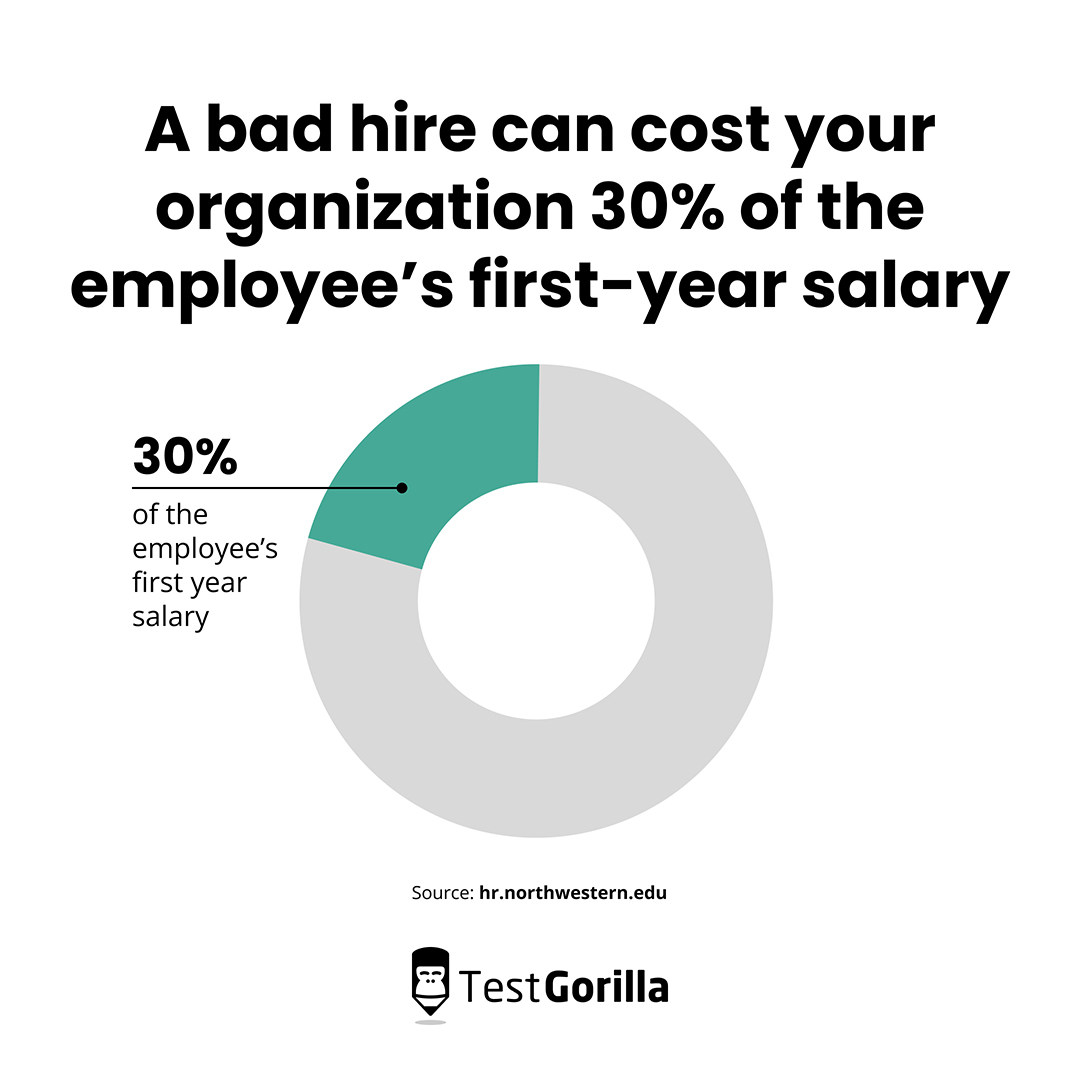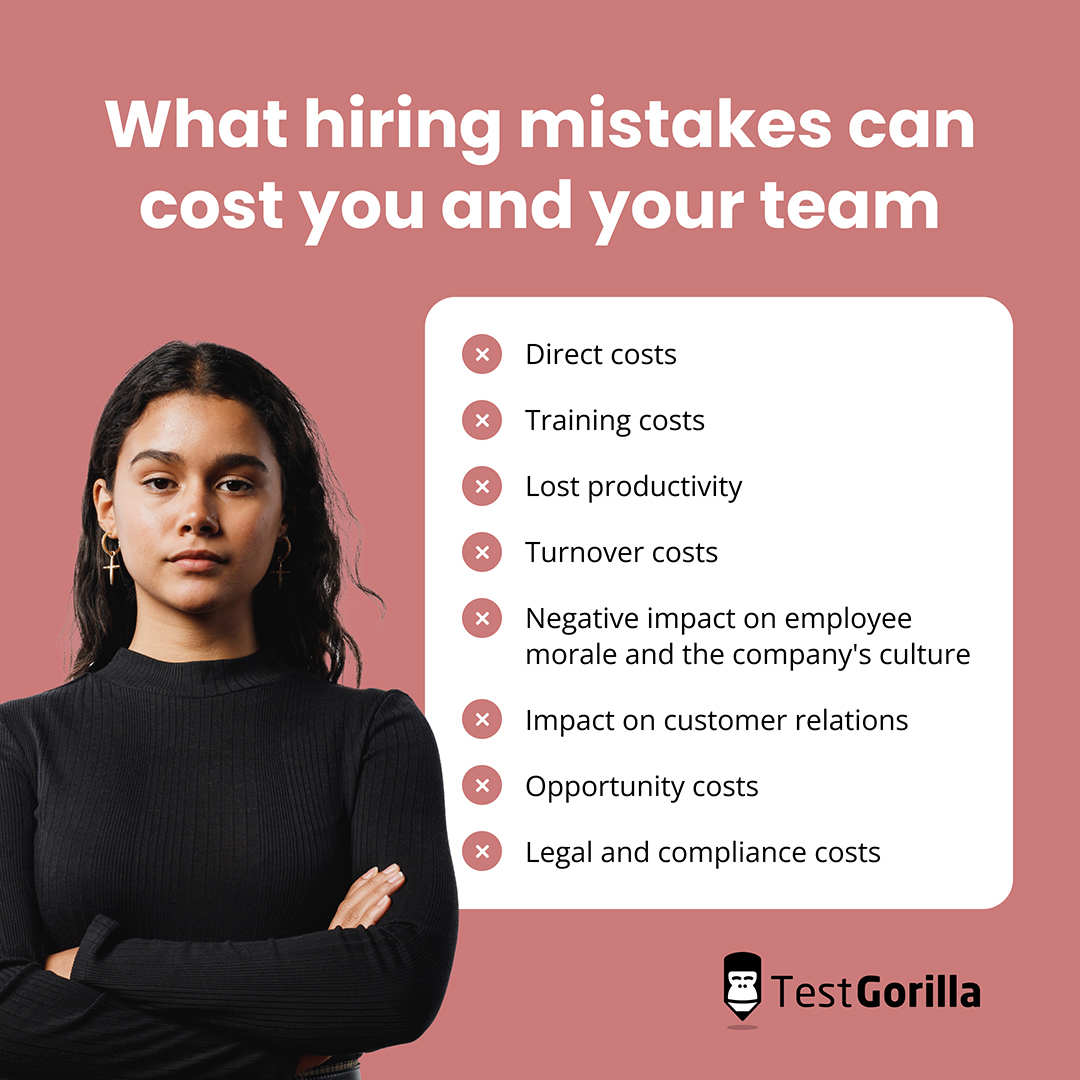9 common hiring mistakes and how to avoid them
Hiring the wrong candidate can be costly for businesses of all sizes. However, even the most experienced hiring managers can sometimes end up with the wrong candidate on board. For instance, 74% of employers admitted in a survey that they have hired the wrong person for a position.
Keep reading as we discuss the true costs of hiring the wrong employee (it's not just about the money), most common pitfalls in the hiring process, and how to avoid them.
We'll also unpacked tips on how to create a successful recruitment process that will help you attract the right candidates and find the best talent.
Let's get started.
Table of contents
- What hiring mistakes can cost you and your team
- 1. Spending too long on the hiring process
- 2. Not considering internal candidates
- 3. Asking for too much
- 4. Not offering enough
- 5. Searching for perfection
- 6. Rushing to make a hire
- 7. Taking too long to close the deal
- 8. Resisting technology
- 9. Ignoring culture add
- Get hiring right the first time with TestGorilla
What hiring mistakes can cost you and your team
While it's challenging to pinpoint an exact dollar amount for hiring mistakes due to the multiple variables involved (discussed in more detail below), the US Department of Labor estimates that a bad hire can cost your organization up to 30% of the employee's first-year salary. Depending on the company and role and the company, these figures can be as high as $240,000.
These costs can include the following:
Direct costs
These are the most tangible costs and include expenses like job advertisements, recruiter fees, background checks, and any relocation costs for the new hire. These costs can range from a few hundred to several thousand dollars.
Training costs
These costs include the time and resources spent by trainers and any training materials. Training costs can add up significantly, especially for specialized roles.
Lost productivity
When a new employee struggles to integrate into the team or perform their duties, there is a direct impact on productivity. Existing team members might need to spend time helping and guiding the new hire, diverting their attention from their tasks. This can lead to a dip in overall team performance and delayed project timelines.
Turnover costs
If a bad hire is recognized relatively quickly and the employee needs to be let go, there are costs associated with severance packages and the subsequent recruitment process for a replacement. This involves starting the entire hiring process from scratch, incurring the same recruitment and training costs again.
Learn more: Employee turnover costs and how to calculate them
Negative impact on employee morale and the company's culture
A poor hire can negatively affect team morale and engagement. Co-workers might feel demotivated if forced to work alongside an underperforming or disruptive team member. This can lead to reduced job satisfaction, increased turnover, workplace negativity, and potentially a toxic work environment.
Impact on customer relations
Hiring mistakes can damage customer relationships, resulting in lost business opportunities and a tarnished reputation. Unqualified or poorly performing employees may provide subpar customer service, leading to customer dissatisfaction and potential churn.
Opportunity costs
Time spent dealing with the aftermath of a hiring mistake could have been used to focus on business growth, innovation, and strategic initiatives. Valuable opportunities could be missed due to the distraction of handling the consequences of a poor hire.
Legal and compliance costs
If a hiring mistake leads to legal issues, such as wrongful termination claims or violations of labor laws, it can result in legal fees, lost expenses, and potential settlements.
It's worth noting that the costs of hiring mistakes can go beyond monetary figures and can impact an organization's overall health, culture, and long-term success. For these reasons, investing time and effort in a thoughtful and thorough hiring process is a must.
This brings us to the next section - the most common hiring mistakes your team should be mindful of and the different ways you can avoid them.
1. Spending too long on the hiring process
One of the hardest parts of finding excellent candidates and hiring new staff is sifting through all of the applications you receive. This is especially true if you still rely on paper applications, it can take a long time to go over each resume as you shortlist candidates and check references. But even digital applications take a lot of time to review.
It’s important to spend enough time on each application to determine whether you should give a candidate further consideration, but you’ll miss out on the right candidate if you spend too much time making decisions at this point.
Job seekers will apply to more than one company at a time. This means there’s competition for every applicant, and if your time-to-hire is too long, the qualified candidate will likely have accepted offers from other companies by the time you are ready to make a hire.
What to do instead
Using online skills assessments (as opposed to reading hundreds of resumes or relying on resume screening software) will make your candidate selection process much more efficient. Why?
Skills assessments show you who actually has the skills you need before you begin the time-consuming process of reviewing resumes.
2. Not considering internal candidates
Sometimes companies can have a valid reason for hiring people from outside the business. Perhaps there is a skill that is lacking, or they are looking for more experience. However, it is important that you are mindful of the employees you already have, their growth potential, and know what they can offer.
By not offering roles to your current team members, existing employees may begin to feel that they don’t have the potential to grow with your company. You may find that you lose frustrated staff as a result.
What to do instead
As a hiring manager, you can avoid this problem by offering positions internally. Some companies try to recruit current employees before they even post the job externally. This gives your team a head start on the competition. But even if you simultaneously post the job internally and externally, your staff will appreciate having an opportunity to move up within the organization.
Learn more: The ultimate guide to internal mobility for HR professionals
3. Asking for too much
Some employers will write misleading job descriptions or pack their job ads and job postings full of required qualities that they want in their employees. This can sometimes include attributes that are not essential for the job.
While you want to find the top candidates and hire the right talent in your company, you are less likely to find the ideal candidate by asking for too much.
What to do instead
Be sure to write a realistic and accurate job description that take into account the skills needed, the seniority level of the role, and the compensation. This way, you’ll be more likely to find the best candidates while not missing anyone that could be the ideal fit.
Read this guide on how to write a good job description - How to prepare job descriptions for a skills-based hiring approach
4. Not offering enough
Staying within your budget will always be a consideration when hiring new employees.
Many companies walk a fine line between staying profitable and spending enough money to expand their business. But now more than ever, candidates know what they are worth, and they are looking for a job that will be realistic in terms of salary. Websites like Glassdoor and Salary.com make it easy for candidates to get a good idea of an employee's annual salary. Plus, videos about salary transparency is also common in social media.
What to do instead
It is worth looking at what other companies are paying their employees if you can. The same websites that candidates will use to research how a role should be compensated can help employers too. You don’t necessarily have to pay more than your competitors, but you should be competitive if you’re expecting to attract the best candidate.
If you don’t have the budget to match what your competitors are paying, then perhaps there are other perks you can highlight (e.g., an office gym, tuition reimbursement, 401k matching, better working conditions, etc.).
5. Searching for perfection
Some employers try too hard to find the perfect candidate for an open position, even when that candidate might not exist. For example, while you might want to find someone that can hit the ground running, you may need to accept that some learning will be necessary.
What to do instead
Consider the skills necessary for the position and whether they require specialized training or are quite common. Will they be working with machinery or hardware that needs specialist training?
If the answer is yes, but you’re struggling to find candidates who have that training along with other skills you need, then you might want to focus on candidates with the other skills you need while planning to train them up in other areas during their first months on the job.
6. Rushing to make a hire
Hiring someone to have the seat filled quickly without doing your due diligence can be as bad as taking too long to hire. There can be a sense of urgency to find the right person, especially if you have other staff covering the role and putting additional strain on them. But by trying to speed through the usual hiring processes, you may miss vital information that could prove costly later.
What to do instead
Try to set a realistic timeline for your recruiting process — from posting job openings on job boards to conducting job interviews to onboarding new hires. You can then relay this to the recruiting team or the hiring managers involved so they know how long it will take to find a new employee. Stay on track and not miss anything vital by setting a timescale for each step.
Plus, ensure that you are taking the time to assess a candidate's ability by conducting online skills assessments.
7. Taking too long to close the deal
Whether it's a phone interview or a face-to-face interview, it’s important to get all of your interview process done as quickly as possible. This will keep all the candidates fresh in your memory and allow you to make a decision without delay.
In addition, candidates might lose interest and accept offers from other companies, losing potential talent. Delayed offers may also increase the likelihood of a great candidate accepting offers from other competitors, putting your company at a disadvantage.
What to do instead
Streamlining communication, establishing clear evaluation criteria, and implementing structured interviews to expedite the decision-making process make sense.
Providing timely feedback and involving key decision-makers early on can prevent delays. This ensures more efficient evaluations and shows genuine interest in candidates, which also reflects your company's values.
8. Resisting technology
These days, resisting technology integration into the hiring process can be a significant misstep for companies. As the job market becomes more competitive, harnessing technology's power to streamline recruitment is necessary.
Failing to do so can result in missed opportunities to screen candidates efficiently, falling behind competitors who leverage HR technology to their advantage.
Traditional methods that rely solely on manual processes consume valuable time and limit access to a broader talent pool.
What to do instead
Ask your hiring managers and human resources team to embrace technological advancements. Implementing applicant tracking systems and AI-driven recruitment tools can expedite candidate screening and identify qualified individuals while eliminating unconscious bias.
You can also use social media platforms for talent acquisition to broaden your reach and target passive candidates who may not actively seek job opportunities but are open to exploring new offers.
9. Ignoring culture add
Many companies hire who they think is the right candidate but inadvertently overlook a vital piece: culture add.
While qualifications and skills are crucial, neglecting how a candidate would fit within your existing work culture can lead to unintended consequences.
A culture add goes beyond just fitting in – it's about how a candidate can enrich the teams they belong to, enhance diversity, and align with company values. Ignoring this aspect can result in hiring individuals who might have the right skills but don't quite blend with the team's collaborative rhythm or contribute positively to the company's growth.
Learn more: Culture add vs. Culture fit: Why culture add is the new way forward
What to do instead
Attract candidates who are great culture add by defining your company culture and values clearly. During interviews, assess candidates for their potential cultural contribution. For example, you can use TestGorilla's Culture add test.
Get hiring right the first time with TestGorilla
Hiring can be a time-consuming and expensive process, so you need to ensure that you are getting it right the first time. The hiring mistakes we’ve covered here can be costly to your business, damaging to your company’s reputation, and lead to missing out on top talent.
By avoiding these pitfalls, you’ll give your company the best chance of finding the right individuals.
Most of all, hire the best and get it right with TestGorilla's skills assessment tests. Get started for free.
Related posts
You've scrolled this far
Why not try TestGorilla for free, and see what happens when you put skills first.
Latest posts
The best advice on pre-employment testing, in your inbox.
No spam. Unsubscribe at any time.

Hire the best. No bias. No stress.
Our screening tests identify the best candidates and make your hiring decisions faster, easier, and bias-free.
Free resources
This checklist covers key features you should look for when choosing a skills testing platform
This resource will help you develop an onboarding checklist for new hires.
How to assess your candidates' attention to detail.
Learn how to get human resources certified through HRCI or SHRM.
Learn how you can improve the level of talent at your company.
Learn how CapitalT reduced hiring bias with online skills assessments.
Learn how to make the resume process more efficient and more effective.
Improve your hiring strategy with these 7 critical recruitment metrics.
Learn how Sukhi decreased time spent reviewing resumes by 83%!
Hire more efficiently with these hacks that 99% of recruiters aren't using.
Make a business case for diversity and inclusion initiatives with this data.




























